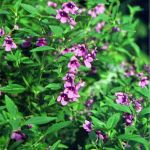| Common Name: |
Round-leaved Mint Bush |
| Botanical Name: |
Prostanthera rotundifolia |
| Genus: |
Prostanthera |
| Family: |
Lamiaceae |
| Cultivation: |
Well-drained soil in sun. Prone to spider mites and whiteflies when grown under glass. |
| Propagation: |
By seed sown in spring at 13-18°C (55-64°F); by semi-ripe cutting in summer. Prune lightly immediately after flowerings. Prostantheras dislike hard pruning. |
| Harvest: |
Leaves are picked as required for infusions, and dried for potpourris. |
| Native Location: |
S and SE Australia |
| Height: |
2-4m (6-12ft) |
| Width: |
1-3m (3-10ft) |
| Hardiness: |
Z9 |
| Parts Used: |
Leaves |
| Properties: |
An aromatic, decongestant herb with a strong, peppery, mint-like flavor. It has anti-bacterial and antifungal effects. |
| Medicinal Uses: |
Externally for colds and headaches. |
| Culinary Uses: |
Fresh or dried leaves are used to flavor meat dishes and sauces, also to make tea. |
| Economic Uses: |
Leaves are added to potpourris. |
| Bibliography: |
Encyclopedia of Herbs by Deni Brown. Copyright © 1995, 2001 Dorling Kindersley Limited. pp 330-331
|

